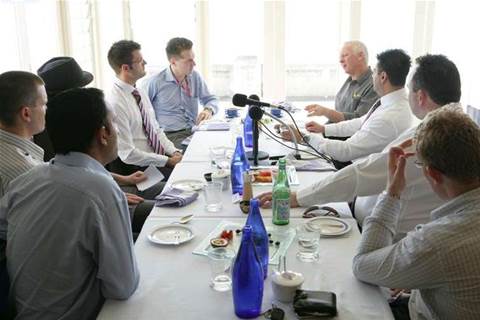CRN: It seems like there's a general problem of trying to demonstrate the value of a coordinated approach so you can move away from an ad hoc style and the problems that go with it.
It must be difficult Alan, on the management side of things. It is easy to understand viruses, but the loss of time and efficiencies with poor management, it must be hard to communicate that too?
Alan Abraham, Landesk: One of the things we're seeing is organisations moving from a technical cost centre, the remote office branch office to more of a strategic approach.
Something as simple as a few months ago, one of the largest hardware vendors had a battery recall on six of their mobile devices. So you've got 40 branch offices across a number of countries, how do you know who has what, whether it's hardware inventory or software inventory or multi-layered.
How do I do end-point security, how do I do patching, how do I install software across these devices without affecting other things like the network bandwidth
So one of the things we talk to organisations about, whether they're enterprise or SMB, we say to have a look at whether the technology is relevant, also is it mainstream?
McKinnel: I think there's a lot more reliance on technology, it's a lot more pervasive and available, but there still seems to be a fixation on the acquisition cost and the ongoing support cost without understanding the life-cycle management cost.
You don't get something for free. So as you become more reliant on IT and deploy more mobility there's a cost associated with it. I think people think it's free and that's where the issue is. It's a case of the costs are now transferred from hard tangible costs, assets and software and so forth, but they're now more soft costs - productivity costs and things like that.
I don't think there's a maturity within small organisations to actually truly appreciate it, quantify it and then try and address that as an issue.
I deal with large procurement entities, banks and telcos, and if you want to see people driven by cost, they are - but they still have a very strong appreciation of the soft costs, brand reputation and things like that, whereas I don't think that mindset, and quite rightly so, in those disciplines are there with an SMB.
Penno: The cost is one side, the return is the other - what return am I getting from deploying these applications on mobile devices or providing remote access or connectivity.
The large organisations probably have a much better idea about [measuring investment and the return on that investment]. Whereas the SMB see the cost but may not necessarily see the return, or have an idea about what the return is but not have any means to measure it.
CRN: Yes, I think that goes to the heart of the problem - SMBs aren't really good at measuring things, whether its costs or return on investment.
Friend: And often they don't see the cost in that ongoing management either, so they look at the initial upfront costs and the returns but they're missing the bit about the ongoing management cost and that's where going with the entire solution can make a big difference. They spend five hours setting up a new laptop when it should only take half an hour.
Penno: Yes, and then spend ten hours a month managing that laptop over time.
Friend: And then they end up hiring an extra person to do it when really, if they'd set it up properly, they could do a lot more.
CRN: Enterprise technologies such as virtual desktops could solve a lot of these problems, at least in theory. SMBs seem reluctant to do such major transformation, the virtual aspect seems to scare away the horses. Where are things at with things like virtual desktops - there should be a big demand for it but are we seeing it, is it happening?
Safi Obeidullah, Citrix: Yes, certainly over the last few years desktop virtualisation has become a lot more popular, particular with the release of Windows 7.
As you said, the requirement from a desktop is a lot different from what it was 10 years ago, it's not just a PC with a mouse and a keyboard, the users demand a lot richer user experience, they want to be able to work from home from different types of devices, access their apps from an iPad for example, things like that.
Next: CRN: Scott, from Allied's point of view, how do virtual desktops affect SMB networks?




_(21).jpg&h=142&w=230&c=1&s=1)

.png&h=142&w=230&c=1&s=1)

.jpg&h=142&w=230&c=1&s=1)




.jpg&w=100&c=1&s=0)







.jpg&q=95&h=298&w=480&c=1&s=1)



